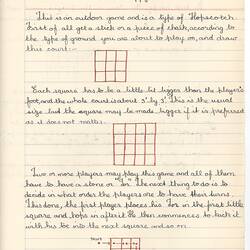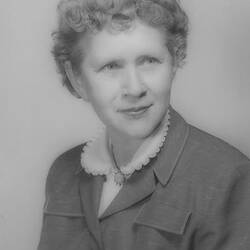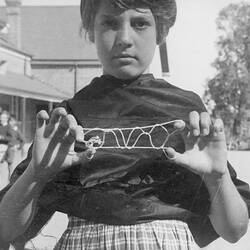Summary
Game name (and type): 'Kick Hoppy' (hopscotch)
Alternative types: hopscotch pattern, games with actions, jumping games, games with found objects, taw use
Handwritten description of the hopscotch game 'Kick Hoppy' composed for Dr Dorothy Howard by Suzanne Cory, a twelve year old student at East Camberwell Girls Secondary School, in 1954-1955. Cory describes 'Kick Hoppy' as a game involving a minimum of two players aged between nine and twelve, some chalk or a stick, and a stone or 'tor' [taw] for each player, which is played outdoors during winter. She provides four, annotated, hand drawn diagrams illustrating the game's layout and progression. To play, Cory writes that players mark out the hopscotch pattern using either chalk or a stick depending on the surface. Each square must be large enough to accommodate the players' feet. Cory explains that players kick their 'tor' through the course following it's path by hopping, jumping, or 'scissors' jumping with legs crossed. She notes that if players or their 'tors' land on a line, they must return to the beginning of the course. Cory lists other players of 'Kick Hoppy' including Brenda Hope, Margot Cory, Faye Williams, and Anne Brookfield.
One of a collection of letters describing a children's game written to children's Folklorist Dorothy Howard between 1954 and 1955. Dr. Howard came to Australia in 1954-55 as an American Fulbright scholar to study Australian children's folklore. She travelled across Australia for 10 months collecting children's playground rhymes, games, play artefacts, etc. This letter, together with the other original fieldwork collected by Dr. Howard during this period, is preserved in the Dorothy Howard Collection manuscript files, part of the Australian Children's Folklore Collection (ACFC), Archive Series 3. The ACFC is an extensive collection documenting children's folklore and related research.
Physical Description
Handwritten game description in blue ink on paper. Comprises two sheets. First page features a letterhead printed in black ink; second page features four, annotated, hand drawn diagrams and borders ruled in red ink. Note: lower, right corner of second page is detached.
More Information
-
Collection Names
Australian Children's Folklore Collection, Dorothy Howard Collection
-
Collecting Areas
-
Acquisition Information
Cultural Gifts Donation from Dr June Factor, 18 May 1999
-
Acknowledgement
Donated through the Australian Government's Cultural Gifts Program.
-
Author
Suzanne Cory - East Camberwell Girls' Secondary School (College), Greater Melbourne, Victoria, Australia, 1954-1955
-
Addressed To
-
Collector
-
Organisation Named
East Camberwell Girls' Secondary School (College), Mangarra Road, East Camberwell, Greater Melbourne, Victoria, Australia
-
Classification
-
Category
-
Discipline
-
Type of item
-
Overall Dimensions
203 mm (Width), 254 mm (Height)
Orientation: portrait. Dimensions include first page only.
-
Keywords





